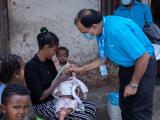Jul 13, 2012
ECDC weighs in on Cambodian EV-71 infections
The recent spate of enterovirus 71 (EV-71) infections in Cambodia might represent the severe part of a wider epidemic of hand, foot, and mouth disease (HFMD) in that area, the European Center for Disease Prevention and Control (ECDC) said today in an epidemiological update. Evidence suggests that the incidence of HFMD and severe EV-71 infections in children have increased in parts of Asia over the past decade. The large size of some of the Asian outbreaks and the elevated risk of neuroinvasive infections with respiratory complications in children make HFMD and EV-71 a major public health worry in affected countries. However, the ECDC said it's not clear why epidemics in Cambodia are just surfacing now, given that HFMD epidemics are ongoing in neighboring Vietnam. The reasons for the scale and severity of EV-71 infections in East and Southeast Asia compared with other parts of the world are unclear, though some experts have suggested that virologic, host, social, and environmental factors could play a role. The ECDC said it isn't aware of any travel-related HFMD or EV-71 infections in Europe, and while the outbreaks in Cambodia appear to increase the geographic distribution of the disease, the events are unlikely to increase the overall risks to visitors. The outbreaks raise important research questions, such as what determines if an EV-71 infection will be asymptomatic or severe. It added that although young age is an important risk factor, it doesn't explain the spread of large outbreaks in Asia. It's unclear if the Asian EV-71 genotypes could cause large outbreaks in Europe, but countries need the capacity to diagnose human enterovirus infections and genotype EV-71 subgroups, the ECDC said.
Jul 13 ECDC statement
World Bank aids 'final' push toward polio eradication in Nigeria
Nigeria has received a $95 million commitment from the World Bank board to continue its ongoing drive toward eradicating polio there, according to a press release yesterday. Nigeria is 1 of 3 countries where polio has not been eradicated, with Afghanistan and Pakistan also still seeing cases. The funding will provide for about 655 million doses of oral polio vaccine for Nigerian children under the age of 5, particularly in the northern states where the disease is more prevalent. The goal of the eradication effort, called the Nigeria Polio Eradication Support Project, is to achieve and sustain 80% polio immunization across all Nigerian states. The monies will come as a "credit" (ie, a loan), through the World Bank's International Development Association, established in 1960 to help the world's poorest countries with projects and programs aimed at improving economic growth, reducing poverty, and improving poor people's lives. The loan will be repaid through the Gates Foundation, the US Centers for Disease Control and Prevention, and Rotary International via the United Nations Foundation when pre–agreed upon results are attained. Dr. Mohamed Pate, an official in Nigeria's polio program, said, "We have beaten back the disease to a large extent already, and with the support of our partners, we are gearing up to make the last big push."
Jul 12 World Bank press release
Scientists trace novel poultry virus to vaccine virus recombination
Australian researchers today described how use of multiple attenuated herpesvirus vaccines in poultry led to the rapid emergence of two recombinant viruses more virulent than the viruses the vaccines were designed to battle. The group described its findings in a brief report in the latest issue of Science. In 2008 soon after a new vaccine against herpesvirus infectious laryngotracheitis virus (ILTV) in chickens was introduced in Australia, scientists detected novel genotypically distinct viruses from birds in several parts of the country. ILTV, also known as gallid herpesvirus 1, is one of the most contagious viruses that affects the poultry industry. The authors hypothesized that the emergence of the new viruses could be related to a European vaccine strain first used in Australia in 2006. When they compared genetic sequences of the novel strains with the European vaccine strain and with two closely related Australian-origin ILTV vaccines that are also used in the country's poultry, they found that the novel viruses were mostly related to the European vaccine strain, though they also contained genetic material from the two Australian vaccine strains. Pathogenicity tests on the novel viruses found that they were more virulent and more able to replicate than the parent viruses. The researchers concluded that the recombination between attenuated herpesviruses is rare but can have serious consequences. They added that the findings have implications for other attenuated viruses.
Jul 13 Science abstract
In a Discover magazine blog post on the study above by Ed Yong yesterday, researchers said the problems aren't likely to translate to human vaccines. Joanne Devlin, PhD, a professor of veterinary public health at the University of Melbourne who coauthored the Science study, told Yong that using more than one live vaccine at a time is a feature of veterinary medicine rather than human medicine. Vincent Racaniello, PhD, a virologist at Columbia University, commented to Yong that it's useful to know vaccine-related recombination can occur but that any danger is probably outweighed by the disease risk. He said the two strains in the inhaled seasonal flu vaccine are weakened by the same mutation and that any recombination would produce an equally weakened vaccine, according to the blog post. Racaniello added that polio vaccine is an exception, because it contains three strains and can rarely lead to vaccine derived polio.
Jul 12 Discover blog post


















